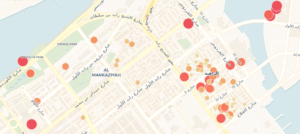
Data and Human Space
NYU Abu Dhabi Fall 2019
CDAD-UH 1033EQ
Core competency: Data and Discovery
Meeting Time/Place: TuTh, 115-230pm, C2 306
Dr David Joseph Wrisley @DJWrisley
Office hours: TuTh 1030-1200, A6 1151, or by appt
This course counts both as a quantitative (Q) and an experimental (E) requirement for the Core. This course will be taught next in remote asynchronous format (with significant modification) in the Fall 2020 semester.
Course description:
Societies have traditionally used maps to represent, even construct, the spaces in which we live and the territories over which we assert control. But what becomes of the map in the (post-) digital age? Has our relationship to human space changed in our data-rich world? Are we unknowingly mapmakers by virtue of walking around with smart devices? This course explores the specific role that technology can play in our understanding of both historical and contemporary map making. Through regional and global examples of urban culture mapping, the course allows students to generate and interpret their own data within familiar environments. In addition to seminar discussion of readings and audiovisual materials, the course will feature guest speakers. It also has a lab component with two main assignments. The first will focus on the history of cartography in the greater Arabian Gulf region. The second will turn to Abu Dhabi itself to see how (and why) we might map some of its spaces using simple technologies. The course assumes no prior computer skills, but a willingness to explore new technologies is essential for success.
Teaching and Learning Methodologies:
- The course will be part seminar, part lab. The seminar portion of the course will involve discussion of selected pages of short readings, podcasts and recorded lectures and writing some reflective research blog postings about them. The lab portion will consist of hands-on creative and technical activities.
- Students will collaborate in group projects, as well as design, create and evaluate project concepts. They will present their practical work to the group incorporating feedback.
- Over the semester we will try out different digital environments–from the easy to the less easy–and use prepared materials to explore analysis of maps with computers. Students are encourage to reflect critically on their engagements with tools and technology for what they allow us, and do not allow us, to say.
- All writing is public and open in research blog format. Students may opt for anonymity in these blogs and may also erase the content at the end of the semester if they so desire. They will also have the option of archiving their work in a digital repository.
- Accessibility will be a persistent point of inquiry in the course.
This syllabus is provided as an open educational resource with a CC BY-SA-NC 4.0 International license. If you reuse it, in part or in whole, please cite it.
Suggested Citation:
NYU Abu Dhabi. (2020). CDAD-UH 1033EQ: Data and Human Space course syllabus. Abu Dhabi, UAE: David Joseph Wrisley.
Keywords: spatial humanities, digital mapping, map visualization, spatial data, culture mapping, historical maps, public history, geocoding, georeferencing, Arab world, Indian Ocean Rim